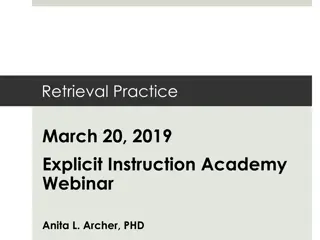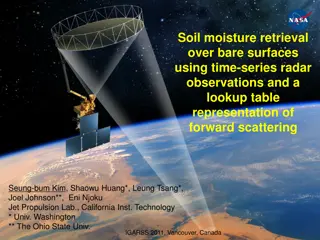Understanding Personal Information Retrieval Behavior
This collection of images and excerpts explores the process of finding and re-finding personal information, focusing on methods such as email search, web browsing, and file retrieval. Insights from studies on orienteering behavior in directed search shed light on how individuals locate specific information, with examples illustrating strategies like directed search expectations and observed search behaviors.
- Personal Information Retrieval
- Information Search Behavior
- Directed Search
- Finding Strategies
- Orienteering Behavior
Download Presentation

Please find below an Image/Link to download the presentation.
The content on the website is provided AS IS for your information and personal use only. It may not be sold, licensed, or shared on other websites without obtaining consent from the author. Download presentation by click this link. If you encounter any issues during the download, it is possible that the publisher has removed the file from their server.
E N D
Presentation Transcript
Finding and Re-Finding Personal Information Jaime Teevan Microsoft Research
How YOU Find and Re-Find Email What s the last email you read? Did you file it? Have you gone back to an email you read before? Web What s the last Web page you (re-)visited? Have you looked for anything on the Web? Files What s the last file you accessed? How did you? Have you looked for a file?
What is Different about Finding Personal Information? Target is often clearly defined A lot of re-finding Know lots of meta-data Know target exists Searcher decided how information was kept
Study of How People Find PI Teevan, J., C. Alvarado, M. S. Ackerman, and D. R. Karger (2004). The Perfect Search Engine is Not Enough: A Study of Orienteering Behavior in Directed Search. In Proceedings of CHI 2004, Vienna, Austria.
Study of How People Find PI Modified diary study of finding behavior Ten interviews each (2/day x 5 days) Two question types Last email/file/Web page looked at Last email/file/Web page looked for Supplemented with direct observation and an hour-long semi-structured interview Subjects: 15 CS graduate students
Directed Search: Expectation Target: Connie Monroe s office number Type into a search engine: Connie Monroe, office number
Directed Search: Observed Interviewer: Have you looked for anything on the Web today? Jim: I had to look for the office number of the Harvard professor. I: So how did you go about doing that? J: I went to the homepage of the Math department at Harvard
Directed Search: Observed I: So you went to the Math department, and then what did you do over there? J: It had a place where you can find people and I went to that page and they had a dropdown list of visiting faculty, and so I went to that link and I looked for her name and there it was.
Directed Search: Observed J:I knew that she had a very small Web page saying, I m here at Harvard. Here s my contact information.
Strategies Looking for Information Teleporting Orienteering
Why Do People Orienteer? Teleporting tools don t work Easier than saying what you want You know where you are You know what you find
Easier Than Saying What You Want Habit Whichever way I remember first. Describing the target is hard Can t Prefer not to Search for source E.g., Your last email search
Easier Than Saying What You Want People know a lot of meta-data Commonly used meta-data in PIM People Time Document type Meta-data often conceptual Person v. email address Time v. last modified time
You Know Where You Are Stay in known space URL manipulation Bookmarks History Backtracking Following an information scent Never end up at a dead end
You Know What You Find Context gives understanding of answer I was looking for a specific file. But even when I saw its name, I wouldn t have known that that was the file I wanted until I saw all of the other names in the same directory Understanding negative results I basically clicked on every single button until I was convinced I don t think that it exists
Individual Factors Affect Finding Search expertise Domain expertise Learning style Organizational style
Organization and Finding Categorize based on email usage 8 Filers 7 6 # of searches 5 4 3 Pilers 2 1 0 0 20 40 60 80 100 % found in Inbox People who pile information take small steps People who file information take big steps
How Individuals Search For Files Keyword Search Other A B C D E F G H Filers Big steps I J K L M Pilers Small steps 0 1 2 3 4 5 6 7 8 9
Searching to Eliminate PIM Organizing and finding behavior related Future value of information hard to predict Post-valued recall Will better search make PIM unnecessary? Keyword search engines alone won t! Provide orienteering benefits (recognition, context) Support reminding What value do we get from organizing?
Applying What We Learned Multi-stepped finding You know where you are You know where you are You know what you find Individual differences Step size varies Target often well defined Highlight sources that contain target type Make search process interactive Integrate different tools used for different steps Support exhaustive search Support different step sizes
Re-Finding Involves Expectation All must be the same to re-find the information! .. But new information can be valuable.
Re-Finding Involves Expectation Solution: Preserve what user expects Supports orienteering for re-finding Allows access to new information
Case 1 Case 2 Case 3 Case 4 Case 5 Case 6
Preserve What User Remembers E.g., example changed during presentation
Summary Personal Information searches unique Lots of re-finding Lots of meta-data Lots of directed search Lots of orienteering Individual differences matter Finding and organizing related Important to match people s expectations
Jaime Teevan, teevan@microsoft.com THANK YOU























